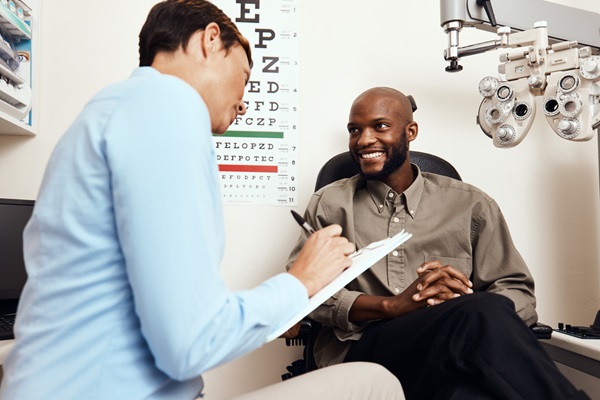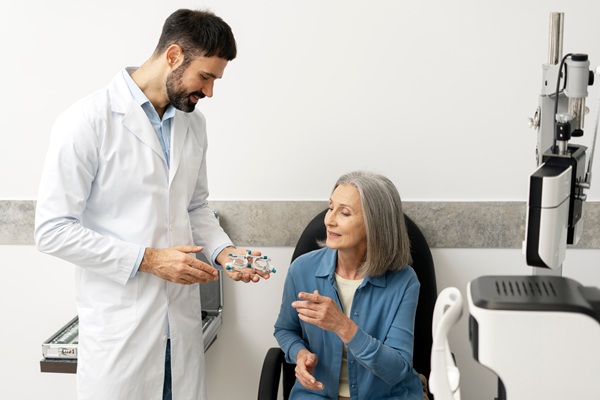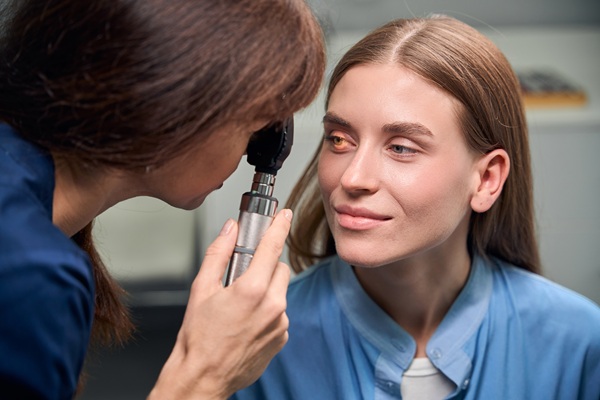What Is a Contact Lens Exam?

A contact lens exam is the most accurate way to ensure that a new corrective lens fits properly on the eye’s surface. Contact lenses that fit well can help you see more clearly without causing dry eyes or discomfort. A contact lens exam is a simple process, and it can even be conducted alongside a standard vision test to get everything done in one session.
The steps of a contact lens exam
Completing a contact lens exam only requires answering a few simple questions from the optometrist, who will guide patients through the process from start to finish.
1. General eye exam
The eye doctor will start with a general family history to explore whether any relatives have experienced problems with their eyes, such as glaucoma. A family history does not necessarily mean a person will automatically develop certain eye diseases, but this information can provide helpful insight into what to monitor over time.
The doctor will also test the patient’s visual acuity, which measures how well they can see clearly. Some people may have no trouble seeing objects nearby but struggle with those far away (or vice versa), while others may have clear vision but fail to accurately perceive an object’s depth or distance. The results of these tests will influence the final prescription for the contact lenses.
Alongside these vision tests, the optometrist will check to see if patients can properly see through their peripheral vision and identify colors correctly. Colorblindness does not typically influence visual acuity, but it can reduce the overall spectrum of hues that a person can perceive.
Finally, the doctor will test the eye’s health overall. They may blow a puff of air onto the eye to check its pressure or flash lights into the eye to examine pupil dilation. The results of such testing can indicate whether the eye is healthy and if not, what to do next.
2. Eye measurement
Once the general exam is complete, the eye doctor can move on to measurements specific to contact lenses. Since a contact fits directly onto the eye’s surface, it is crucial to determine what shape it should be so it sits comfortably.
The first element of a contact lens measurement is the base curve. This number describes the angle of curvature of the individual’s eye. Some people have eyes that curve significantly outward, while others' are flatter. The contact lens will match this curve so the full surface of the lens clings to the eye.
Next, the doctor will measure the diameter of the eye. While most eyes are almost the same size, even a millimeter of difference can interfere with prescription contacts and how they focus. The diameter measures how big the eye is in a straight line.
Finally, the doctor will identify the patient’s pupil size. The contact must focus light into the pupil, so measuring its size allows for a prescription that centers the lens correctly over the middle of the eye.
3. Lens fitting
Now that measurements are complete, the optometrist will usually offer the patient a set of trial contacts. They will examine the eyes once the contacts are in to see whether they move and if they are centered. This provides critical information about fit and enables the doctor to tailor the prescription to the specific patient.
They will also likely test visual acuity again to see if the lenses helped. If not, they can identify whether the problem is with the prescription, the fit, or something else.
4. Material choice
Based on the testing results so far, the eye doctor can recommend contact lenses made of a material that suits the patient. Some people with dry eyes need lenses that trap more moisture, while others need breathable contacts if they plan to wear them for more than a few hours at a time. Patients with astigmatism, an unevenness in the curved surface of the eye, may need contacts made of certain materials to adapt to these unique patterns and inconsistencies.
Get properly fitting contacts
Contact lenses can change how you view the world, enabling you to see clearly without the obstruction of glasses on your face. However, the best results come from having contact lenses properly fitted during a contact lens exam. Contact our team to schedule a contact lens exam and discover how personalized lenses can improve your quality of life and keep you comfortable throughout the day.
Request an appointment here: https://www.texasoptical.net or call Texas Optical at (214) 771-7333 for an appointment in our Dallas office.
Check out what others are saying about our services on Yelp: Read our Yelp reviews.
Recent Posts
Red, itchy eyes can affect your everyday comfort and reduce overall well-being. It is important to seek effective vision care from the first sign of irritation. Proper attention to symptoms, underlying causes, and healthy habits ensures stronger long-term eye health and greater day-to-day clarity. Redness and itchiness often stem from several common triggers. These include: Allergic…
New spots or shadows drifting across vision can be unsettling, and sudden changes sometimes require emergency eye care to protect long-term sight. Many floaters are harmless, but others signal serious problems with the retina or internal eye structures. Understanding when floaters are normal and when they point to a true eye emergency helps patients act…
Glaucoma treatment plays a vital role in preserving vision and protecting the optic nerve from further damage. Many patients rely on daily eye drops to manage intraocular pressure, but these medications can sometimes come with side effects. Understanding how to recognize, minimize, and communicate about these effects supports long-term success and comfort with treatment. While…
Progressive lenses offer clear vision at near, arm's length, and far distances without the visible lines found in bifocals. They provide a smooth change in power from top to bottom, which means the eyes can focus comfortably throughout the day. With the right fit and guidance from an optometrist, progressive lenses help reduce eye strain…


